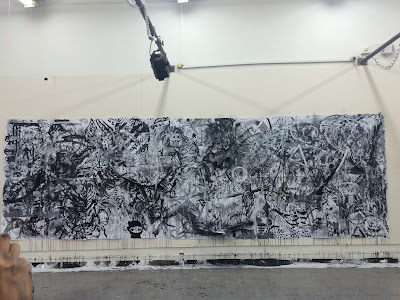So the brief for this class, (which I was not able to attend), suggested that I create some Rorschach tests. Rorschach tests were originally intended to gain some insight into the subconscious, however their accuracy for this purpose has not been substantiated to me or my partners satisfaction.
It reminded that I had actually rewritten (ported) some code that kind of generates them.
I was looking around being interested in digital painting and I thought it would be a good place to start by looking at what someone else was doing, and then do it better.
I found an OpenProcessing sketch http://www.openprocessing.org/sketch/4675
That produced some satisfying results once tweaked a little bit (images at the bottom).
I rewrote it in another language, developed a GLSL shader for the threshold effect and optimised it so that it ran significantly faster on slower machines (order of magnitude increase), the extra speed made it more satisfying as I was able to keep the effect and the movement was more fluid.
I then went one step further and created multiple layers of a GLSL noise warp shader (the thing that warps everything a a bit) at different frequencies, this gives the video a kid of inkblotty effect that I really like and so I've included this in my global bank of shader combinations and fx. I've linked a video of this effect at the bottom.
The next thing that I would like to experiment with is using a harmonic relationship with the noise frequencies rather than a linear one. Currently the frequencies go from { 1 - 16 } in steps of one, and I would rather they go something like {
4 (32/8),
4.514285714... (32/7),
5.333... (32/6),
6.4 (32/5),
8 (32/4),
10.666... (32/3)
, 16.0 (32/2),
32 (32/1) }
. My reasoning for this is that I read about (and have used before) this thing called "harmonic noise", but up until doing this project I had not considered what that actually means.
I would also like to experiment with changing the speed of the noise movement, as I think that the movement of the finer grain noise is too high (I suppose I could make it zero).



















































